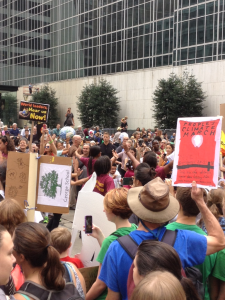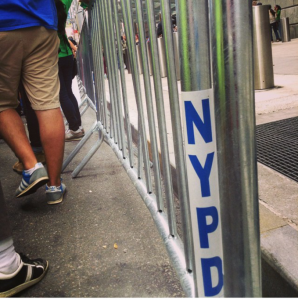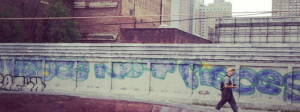Popular Disruption | People’s Climate March
On Sunday September 21, 2014 nearly 400,000 people gathered along the west side of Central Park to march through New York City, the financial and corporate capital of the world, to tell our world leaders it was time – in fact more so, that it had been time – to take real action to counteract the effects of climate change.
This is one person’s account of that event.

SEPT 22, 2014: It was only the day before the People’s Climate March that I learned of the corporate sponsors, and the city permit that was obtained by organizers. When I arrived on the scene on the muggy Sunday morning these realities of the march were apparent in the infrastructure that had been assembled to enable and organize the marchers. I was immediately reminded of the days I used to work down at a restaurant in Times Square, one block over from the Thanksgiving Day parade: police were everywhere, streets had been barricaded off so as to allow for more pedestrian foot traffic, there were barricades designating where groups and individuals could line up to join the march, there were gatekeepers telling us where certain groups could or couldn’t line up, and there were spectators lining up to observe the ‘festivities’. My opinion of the march started slipping into step with some of those on the far left who had or were denouncing the march as too complicit with the powers and structures that be and thus, ultimately ineffectual. I found myself agreeing that, on the surface at least, it seemed more like a parade than a representation or manifestation of the people putting forth a political demand; particularly in the context of my previous experiences with this sort of political expression.
When we marched down 5th Avenue as underserved graduate students, underpaid professionals and supporters of the Occupy movement in the Fall of 2011 there were no permits or barricades, and the only police we saw were those trying to cut off our route and telling us to go home. We marched illegally in the street, holding up traffic – car, foot, bike and otherwise – as a form of protest and political expression, as a manifestation of our opposition to and discontent with the current order, and as a demand for something better. Our seizure of the commons was more than a symbolic gesture – it felt real, and not manufactured. When we arrived at our alternative destination, Union Square – because the efforts of the police in blocking us from reaching Washington Square Park proved to be successful – we huddled around each other in the bitter late-fall cold and listened to others share their grievances. It was a raw and emotional hour or two that restored my faith in humanity, and made me feel less alone. This action felt productive, and I felt like I was able to explore the anger and sadness I felt toward our political economic order that had been building since the recession, since I graduated college, and since I had come to understand the structures, processes and policies that constructed my life in a way that was more challenging than it had to be.
In contrast, as I mentioned, Sunday felt calm, and manufactured, at least in the beginning. Throughout the course of the day, as we winded through the center of Manhattan at a snail’s pace, I continued engaging with the question of what we were actually achieving: down the west side of a (mostly) privately-funded park that came to be as a result of conservation politics, around Columbus’ circle, a testament to our nation’s history of atrocious and too-often-unacknowledged genocide, past the looming homes of many corporate giants and their lawyer-ing defenders on 6th avenue, across 42nd street and through the heart of the ever-privatizing and -militarizing tourist center of Times Square, and eventually to the end, in the middle of nowhere on 11th avenue and 34th Street, in the gaps that house the other things the city prefers to hide or conceal from New York’s visitors. As we went, people lined the outside of the ‘parade cage’ with their decorated signs and thematic t-shirts. Others hung out of their office or apartment windows. They cheered and waved and whistled, and yelled, egging us on as we went.
After two or three hours of marching, we were still only to 46th and 6th ave. People were getting tired of standing, or walking so slowly. Bathroom breaks were in order, and even lunch maybe. All of a sudden the barricades locking us in became porous – with many hopping and climbing over them – in and out. At some points the barricades seemed to become a part of the crowd as marchers used them to obtain an aerial view of the mass that had joined them in their mission. There was also a joyous marching band that showed up around that time – seemingly from out of nowhere, probably from the other side of the gate – and rejuvenated the crowd. And dancing and giggling and clapping ensued. And we continued.
As the day wore on I came to reject my initial apprehensions; just because it was structured by an outside force didn’t mean we weren’t in control. I became aware of the real power of what we were doing.

Despite the city’s efforts and desires to feel “in control’ of the march, the barricades couldn’t keep people in, or out for that matter. The spectators were just as much a part of the political display as those procession-ing between them. This swarm of people created a new and meaningful kind of disruption to the corporately-planned walkways of Times Square and 6th avenue. A shunning of the bright lights and carefully placed advertisements was encompassed in the 800,000 feet that reclaimed that space and imbued it with new meaning, even if only for a day. And the multitude of signs condemned, taunted and shamed the means of productions that supported the corporate appartus as we passed through. In our call for a new way of being and set of values, we, maybe even unconsciously, provided an example of that might look like. We replaced the spaces sterilized by privatization and corporate power with a vibrancy only characteristic of community and a power stemming only from human capacity.
Thinking back to the structure of the march, if it was the legality of the march, ensured by the obtainment of permits and the involvement of the protection of the police, that allowed this march to be a place that made so many people feel comfortable, or less at risk for sacrificing the other aspects of their lives, which ultimately enabled so many of them to come together, so be it. Political power and awe and mobilization come not from the illegality or the adversity faced by those protesting, or the adversarial relations developed with the police. In this case, our power comes from a sheer display of force and support evidenced in the numbers of those who showed their membership to this community and this cause on that day. Moreover, should we need to gather again, and history would suggest that this is likely the case, we should take comfort in knowing that our graceful and ordinary display yesterday (on September 21, 2014) will only encourage more to take our claims seriously and perhaps join our forces in the future. This was and needs to be a ‘popular disruption’.
Yesterday John Kerry was quoted in several publications and virtual forums for putting climate change in the same sentence and on the same level as ISIS, and Ebola, two currently recognized global threats. This is unprecedented.
On Sunday September 21, 2014 over 400,000 people gathered along the west side of Central Park to march through New York City, the financial and corporate capital of the world, to tell our world leaders it was time – in fact more so, that it had been time – to take real action to counteract the effects of climate change.
And so far, it seems like they were heard.
What sort of actual effects – policy or otherwise – this ends up having are to be determined on Tuesday, and later this year in Lima. But for now, people came, people walked, and their footsteps were heard, the cries and whistles carried, and their signs were read.

Posted on: August 1, 2015